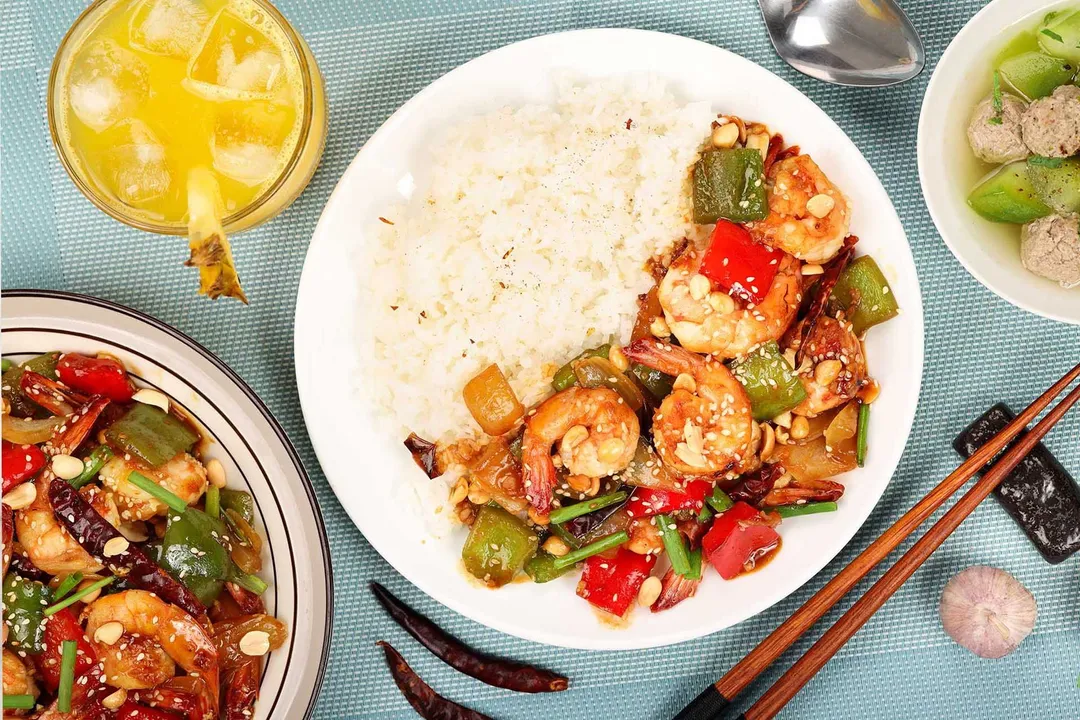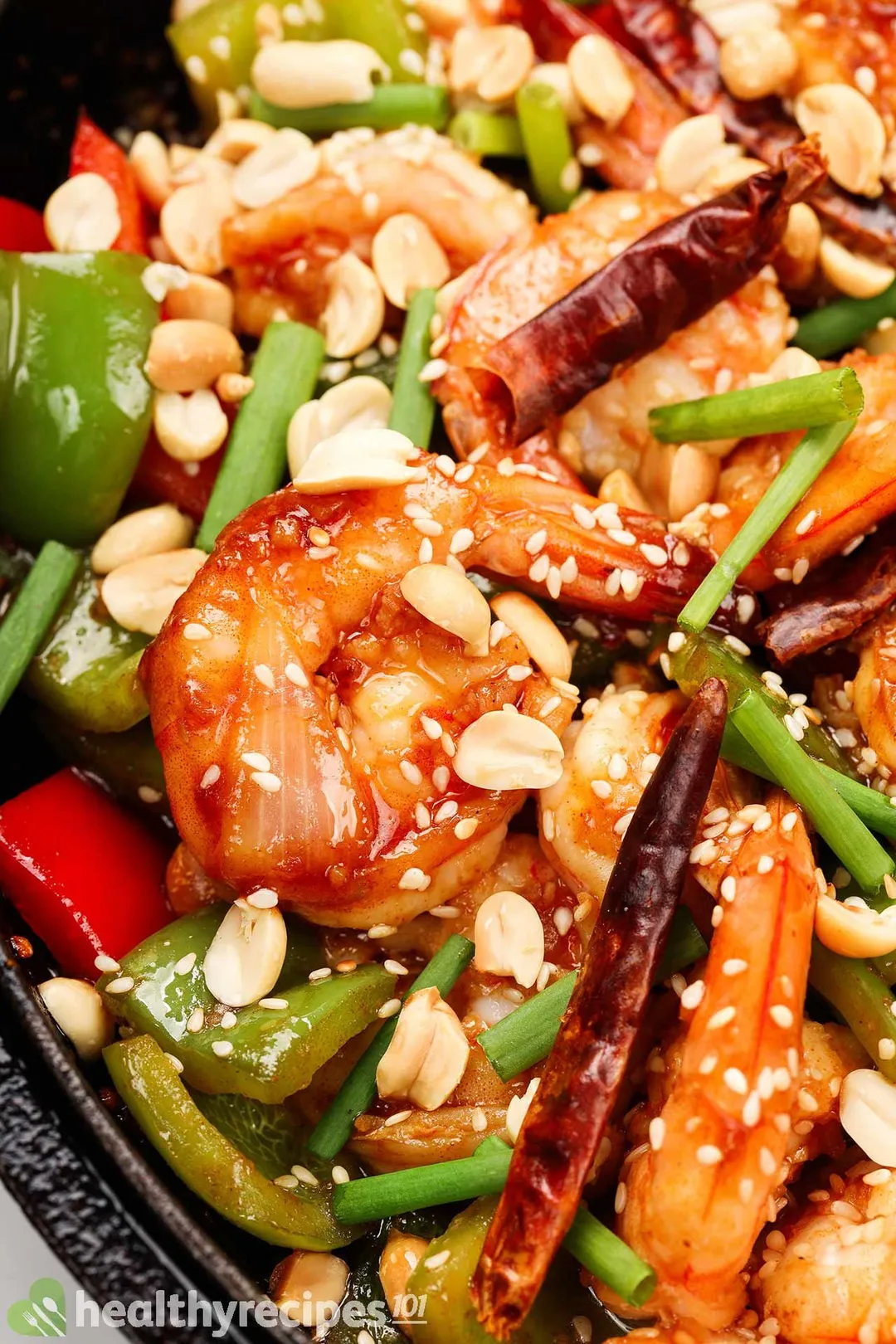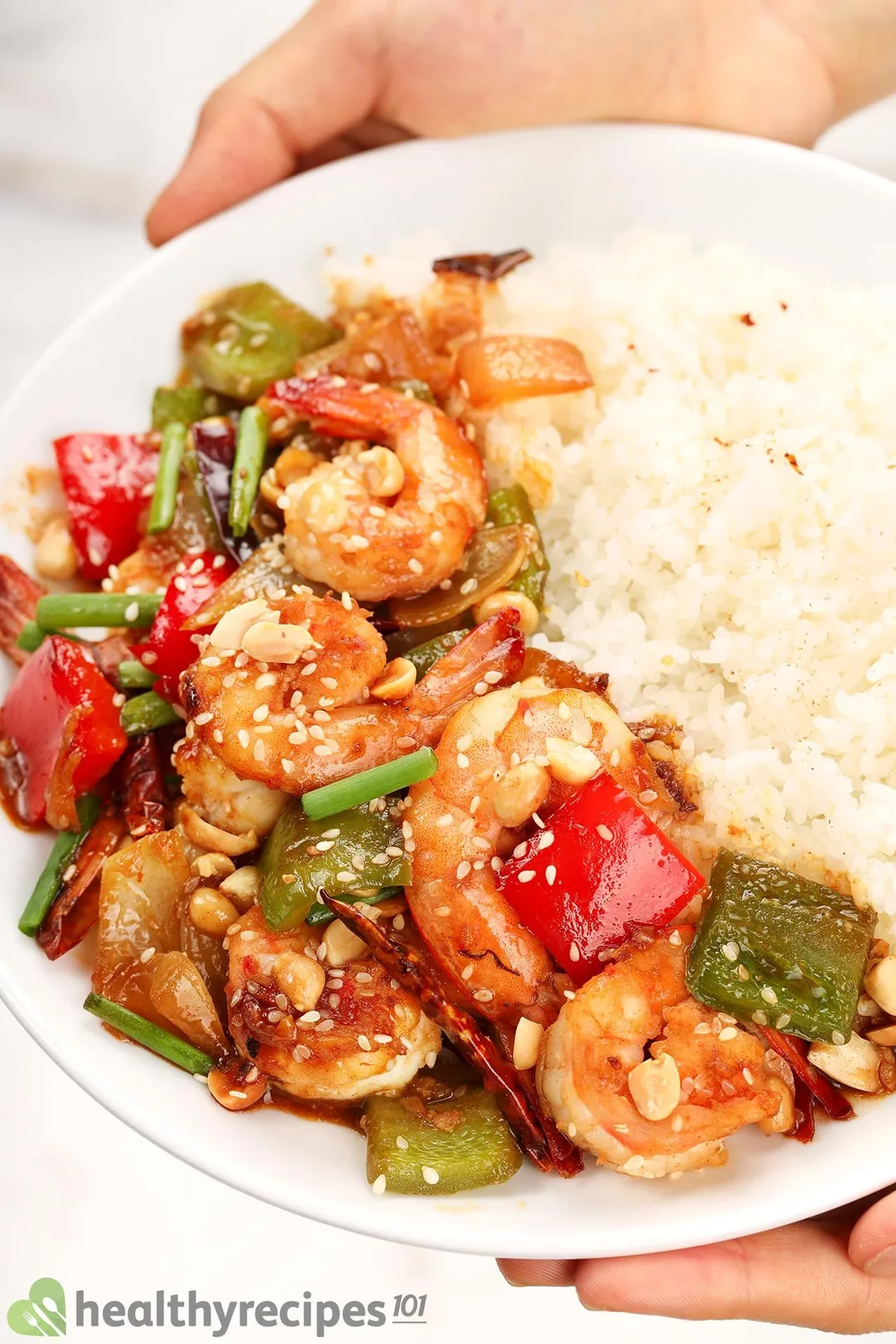This Kung Pao shrimp recipe combines simple ingredients to turn out a delicious stir-fry of crisp bell peppers, savory shrimp, and toasted peanuts. Everything is drenched in a spicy, salty, and sweet glaze that goes over the top of cooked rice for a wholesome, practical meal.
The dish is also an easy make-ahead, meaning your meal preps can be a breeze. Spend just 20 minutes and you’ll have 4 servings (or more) to eat for dinner and save for later.
What Is Kung Pao Shrimp?
Kung Pao is a spicy Chinese stir-fry composed of crisp vegetables (typically onions and bell peppers) and a protein of choice — shrimp, in this recipe. Green beans and snap peas are sometimes used in place of or alongside the bell peppers, lending the dish a fresh element.

What makes Kung Pao dishes special is the sauce made with sugar, soy sauce, sesame oil, dried chilies, and sautéed aromatics. There’s more to the list, but these alone create an addictive sauce that pulls everything together.
If you want more Kung Pao dishes, feel free to try our chicken and cauliflower versions.
Kung Pao Shrimp vs Szechuan Shrimp
Kung pao shrimp has a signature dark sauce that tastes sweet, salty, sometimes tangy, and a little hot. Szechuan shrimp, on the other hand, is a dry stir-fry. It tastes a lot more intense, and for good reason.
Szechuan (or Sichuan) is a region in China that’s humid year-round and where it rains all the time. To cope with such cold and wet weather, people incorporate tons of dried chilies into their dishes to feel some warmth.
Besides chilies, the dishes are loaded with intense Chinese spices, seasonings, and Szechuan peppercorns. These peppercorns taste citrusy at first, but they’ll soon numb the tongue and help to ease the heat from chilies.
Is This Recipe Healthy?
Yes, at least relatively so. Plus, we did one thing to make it even better.
Kung Pao dishes have bell peppers that pack lots of micronutrients, especially vitamin C. The amount we’re using (2 oz per serving) alone provides you with 59 mg, about 65-84% of the recommended daily allowance (RDA).

Our main ingredient, shrimp, contains a great deal of protein (41.5 g in each serving). It’s also known to be a good source of omega-3 and omega-6, healthy fats for the body.
People say shrimp is bad because it has cholesterol, but it’s still yet to be proven. Until it is, it’s better to set more realistic goals. We focus on limiting our intake of saturated fat, sodium, and calories.
We limited these to 1.9 g, 541.1 mg, and 501 respectively, in compliance with our guidelines. That’s done to leave space for appetizers, snacks, drinks, etc. that you might also have during the day.
What’s in Kung Pao Shrimp?
To make Kung Pao shrimp, you first need to have shrimp, either fresh or frozen. We prefer using frozen shrimp that’s peeled, de-veined, and with heads removed. It just makes preparation easier.
In terms of the veg, bell peppers and onions are the easy options, to which you can add other crisp veggies like snap peas or green beans. We use both red and green peppers to keep the dish colorful, but feel free to stick to just one color if you like.
The third element is the sauce made with:
- Garlic and ginger, two important aromatics in Chinese cuisine. We’re not mixing these two with other ingredients, but instead, sautéing them with the shrimp to get more flavor.
- Soy sauce. Asian brands like Lee Kum Kee or Kikkoman make uniquely fragrant soy sauces that complement the food better.
- Oyster sauce, a sweet, salty, savory seasoning that adds both flavor and thickness to the sauce. You can skip it and use soy sauce with 1 tsp sugar instead, if you prefer.
- Brown sugar, the sweetening element. Substitute it with white sugar, honey, or corn syrup if you wish.
- Sesame oil, lending the sauce a nice toasty aroma.
- Cornstarch and chicken broth, giving the sauce that thick consistency to coat the components. Chicken broth also adds a depth of flavor.
- Paprika (and dried chilis). Controlling the heat is easier with paprika. If you want to make something spicier, cut the dried chilis open and enjoy the intense heat.

Before serving the stir-fry with cooked rice, we topped it off with toasted peanuts, sesame seeds, and chopped scallions. A little nuttiness and pungent freshness make a world of difference.
How to Store and Reheat
Properly sealed in an air-tight container, this shrimp dish can be kept in the fridge for 5 days or in the freezer for up to 3 months. If you’re storing cooked rice as well, the fridge will keep it for weeks.
To reheat, place the shrimp in a pot and simmer over low heat with 1-2 tablespoons of water for 3-5 minutes. For the rice, either steam it for 5 minutes or microwave it with 1 tbsp water for 2 minutes, stirring occasionally.
What to Serve With
Chinese meals are often completed with a soup, so we picked our winter melon meatball soup from among the archives. It’s full of tender squash and savory meatballs, balancing out the stir-fry’s deep flavors.
Finally, we finish it out with a tantalizing fusion of orange and pineapple juice. It’s tangy and sweet, a classic fruity drink that suits all occasions.

Want More Chinese Shrimp Dishes? We’ve Got Plenty!
Better yet, check out this complete collection of Asian Shrimp Recipes.
Kung Pao Shrimp Recipe
This Kung Pao shrimp recipe is quick and simple, so it's easy to implement into your everyday routine. It's packed with some of the best Chinese flavors.
- cook TIME 15 mins
- prep TIME 5 mins
- total TIME 20 mins
- COURSE Main Course
- CUISINE Chinese
- SERVINGS servings
- CALORIES 501 kcal
INGREDIENTS
- 24 oz raw shrimp (about 24 medium (12 oz if peeled))
- 4 tbsp unsalted chicken broth
- 2 tbsp reduced-sodium soy sauce
- 1/2 tbsp sesame oil
- 1/2 tbsp sesame seeds (toasted)
- 2 tsp cornstarch
- 1 tsp brown sugar
- 1 tsp hoisin sauce
- 1 tsp paprika
- 2 tbsp olive oil (divided)
- 4 oz red bell peppers (about 1 medium, cut into chunks)
- 4 oz green bell peppers (about 1 medium, cut into chunks)
- 1 oz peanuts (toasted)
- 3 oz onions (about 3/4 a medium, cut into chunks)
- 2 tbsp garlic (about 3 cloves, minced)
- 1 tbsp ginger (about 1 small knob, finely chopped)
- 2 tbsp green scallion (about 2 sprigs, cut into 1-inch segments)
- 6 dried chilis (or to taste)
- 3 cups cooked medium-grain rice
INSTRUCTIONS
In a bowl, mix together 4 tbsp chicken broth, 2 tbsp soy sauce, 1/2 tbsp sesame oil, 2 tsp cornstarch, 1 tsp brown sugar, 1 tsp hoisin sauce, and 1 tsp paprika. Set aside.

Heat 1 tbsp olive oil in a large skillet over medium heat. Add 4 oz red bell peppers, 4 oz green bell peppers, and 3 oz onions, and sauté for 3 minutes. Place the cooked vegetables in a bowl and set aside.

Add another 1 tbsp olive oil to the skillet. Sauté 2 tbsp garlic and 1 tbsp ginger for 30 seconds, then add the shrimp to sear. Stir them around so each shrimp touches the skillet, and leave them be so they sear nicely. After about 3 minutes, move the shrimp around and flip to sear the other side for 2 minutes.

Add the cooked vegetables back to the pan and stir everything for 1 minute. Stir the sauce (the cornstarch will have settled to the bottom) and add it to the skillet. Allow it to reduce for about 1 minute.

Turn off the heat. Mix in 6 dried chilis, 1 oz toasted peanuts, and sprinkle on top 2 tbsp chopped scallion and 1/2 tbsp toasted sesame seeds.

Serve with 3 cups cooked rice and enjoy.

NUTRITION
Tuyet Pham
Head Chef, Culinary ConsultantLuna Regina
Writer, AuthorLizzie Streit, MS, RDN, LD
Nutrition Reviewer
- DowellThe tender shrimp and crunchy vegetables are coated in a delicious sauce that's sure to satisfy your taste buds.


